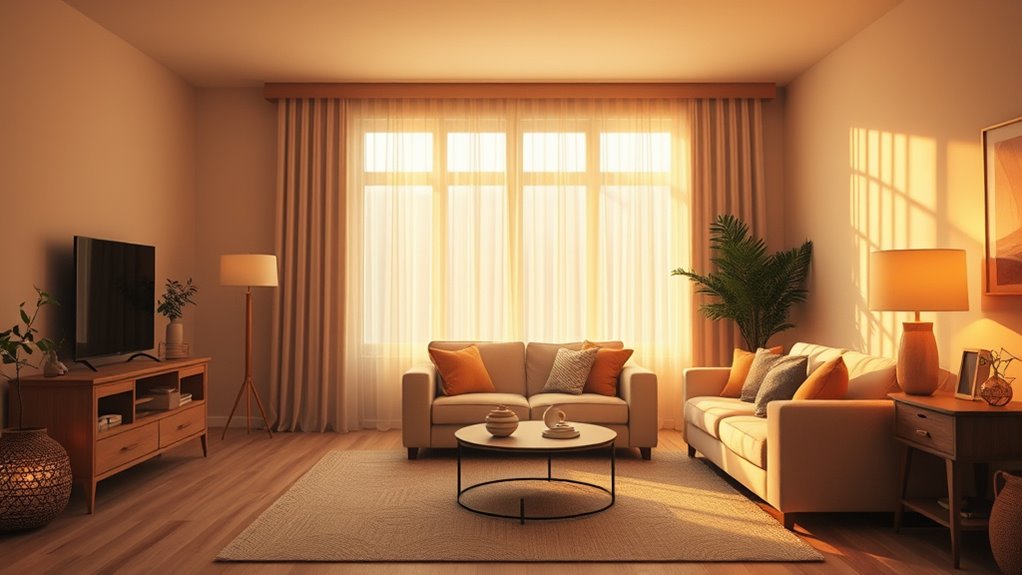To design your home for reduced sundowning, focus on consistent lighting that mimics natural daylight, with soft, warm tones and dimmable fixtures to create a calming atmosphere. Use muted colors like blues or greens and incorporate contrasting elements, such as darker steps, for safety. Keep routines predictable with regular lighting patterns and familiar furnishings to minimize confusion. If you look further, you’ll find practical tips to create a safe, soothing environment that supports better evenings.
Key Takeaways
- Use consistent, natural lighting during the day with dimmable, warm lights in the evening to promote calmness.
- Choose muted, soft colors for walls and furniture to create a relaxing environment.
- Establish a predictable daily routine with regular lighting patterns and consistent timing for activities.
- Highlight boundaries and pathways with contrasting colors for safety and easy recognition.
- Minimize shadows and clutter to reduce visual confusion and support safe navigation.

As the evening approaches, many individuals with dementia experience increased confusion and agitation, a phenomenon known as sundowning. You can help ease this challenging time by designing your home environment thoughtfully, focusing on light, color, and rhythm. Proper lighting is central to reducing sundowning symptoms. As daylight wanes, you want to maintain a steady, natural light level to prevent sudden darkness that can cause disorientation. Use bright, full-spectrum bulbs that mimic natural sunlight during the day, and consider installing dimmable fixtures so you can gradually reduce light levels in the evening. Avoid harsh or flickering lights, which can cause discomfort or confusion. Instead, opt for soft, warm lighting that creates a calming atmosphere. Placing lamps in hallways and common areas ensures consistent illumination, reducing shadows and visual confusion that might trigger agitation. Additionally, incorporating consistent lighting patterns can further reinforce a predictable environment, helping to soothe those experiencing sundowning.
Color choices also play a crucial role in creating a soothing environment. Bright, contrasting colors can sometimes confuse individuals with dementia, making navigation more difficult. Stick to muted, calming tones like soft blues, greens, or warm earth tones, which promote relaxation. Keep walls and furniture in these gentle shades to foster a peaceful setting. Avoid overly bright or patterned wallpaper that might be overstimulating or distracting. Clear, simple color schemes help your loved one recognize spaces more easily and reduce feelings of disorientation. Additionally, using contrasting colors on doorframes, stair edges, or furniture can improve visibility and safety without overwhelming the senses. For example, a dark-colored strip on a step or a contrasting door color makes it easier to identify transitions and boundaries.
Rhythm in your home’s design can help create a sense of consistency and predictability, which is comforting for someone with dementia. Establishing a daily routine with consistent timing for meals, activities, and rest helps anchor their day. You can reinforce this rhythm by maintaining regular lighting patterns—bright during the day, dimmer in the evening—to signal the transition from activity to rest. Keep furnishings and layout simple and familiar to reduce confusion. A predictable environment minimizes surprises and helps your loved one feel more in control. Incorporate familiar objects and routines into the space, and ensure pathways are clear and uncluttered so they can navigate safely without unexpected obstacles. This sense of order and familiarity fosters calmness and reduces the likelihood of agitation during the vulnerable hours of sundowning. By thoughtfully integrating light, color, and rhythm into your home, you actively create a supportive environment that can greatly ease the difficulties associated with sundowning.
Frequently Asked Questions
Can Outdoor Lighting Influence Sundowning Behaviors?
Yes, outdoor lighting can influence sundowning behaviors. When you use consistent, gentle lighting outside, it helps regulate your loved one’s internal clock, reducing confusion and agitation as evening approaches. Bright, harsh lights can worsen symptoms, while soft, warm outdoor lighting creates a calming environment. By adjusting outdoor lights to mimic natural sunset tones and maintaining regular lighting routines, you support better mood stability and decrease sundowning episodes.
How Do Natural Light Cycles Affect Dementia Symptoms?
Natural light cycles help regulate your loved one’s internal clock, reducing confusion and agitation. When they receive exposure to sunlight during the day, they tend to sleep better at night and experience fewer sundowning symptoms. You can encourage this by spending time outdoors or opening curtains during daylight hours. Consistent exposure to natural light supports their circadian rhythm, making evenings calmer and more predictable.
Are There Specific Color Schemes That Calm Agitation?
You’ll find soft, warm colors like gentle blues, greens, and earthy tones soothe agitation effectively. Studies show calming color schemes can reduce aggressive behaviors by up to 30%. You should avoid bright reds or overly stimulating hues, which can increase stress. Using muted, natural shades creates a peaceful environment, helping your loved one feel more secure and relaxed as the day progresses.
What Sounds or Rhythms Can Help Regulate Daily Routines?
You can regulate daily routines by incorporating gentle, consistent sounds and rhythms. Play soft, calming music or nature sounds at regular times to establish a familiar pattern. Use rhythmic activities like walking or clapping to signal shifts between tasks. These steady auditory cues help create a predictable environment, reducing confusion and agitation. Consistency in sound and rhythm offers comfort and stability, making daily routines easier to follow.
How Can Technology Assist in Creating a Soothing Home Environment?
Think of technology as your personal Da Vinci, painting a calm, soothing environment. You can set smart lighting that mimics natural daylight, helping regulate mood and sleep patterns. White noise machines or calming playlists create a peaceful atmosphere, while motion sensors gently guide movement without confusion. These tools work together to craft a home that’s both comforting and supportive, easing the challenges of sundowning with modern ingenuity.
Conclusion
By shaping your home with thoughtful light, calming colors, and gentle rhythms, you create a sanctuary that guides your loved one through the fading sun. Think of your space as a lighthouse, steady and reassuring amid the twilight. Every detail becomes a beacon of comfort, helping to ease confusion and agitation. When your home reflects peace and consistency, it becomes a safe harbor, transforming sunset into a gentle passage rather than a storm.









